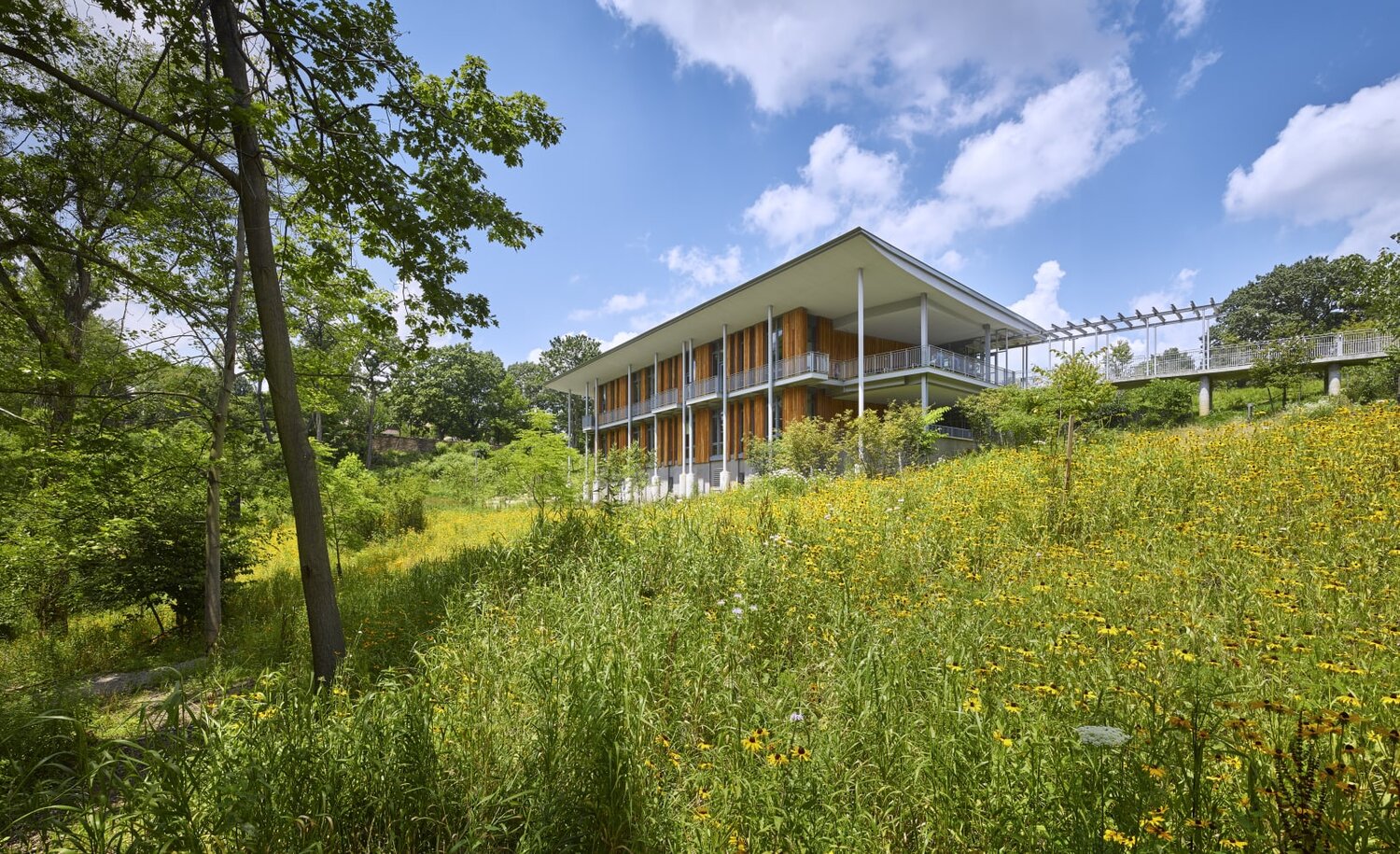Written by Erin Herock
I’ve always loved cities. Growing up near Pittsburgh, I remember how excited I was when my parents took me downtown. When I was old enough to drive, I took any opportunity to hangout in Frick Park with friends or walk along North Shore before going to a concert. I know I’ll always want to live in a city (or at least near one). But, I also find myself spending a lot of time outdoors, craving the natural landscapes that bring me so much joy and relaxation. Can we have both nature and city life?

Frick Park Environmental Center – https://www.aia.org/showcases/6130374-frick-environmental-center. I worked here my freshman year summer with Pittsburgh Parks Conservancy.
My desire to live in a city also stems from the role cities play in reducing our overall environmental impact. The best way to protect our environment is to stay out of it. Urban sprawl is the large scale, quick development of suburban areas. This leads to water and air pollution, increased traffic and jams, parking, and more environmental issues (Spirkova 2020). By condensing where we live, we leave more land to be untouched, which is not only better for ecosystems to function, but also for us too. Not only do traffic jams and parking affect the environment, but it also affects us too in terms of stress, more accidents, anxiety, and social isolation (Pohanka, M. & Fitzgerald, S., 2004).

Nature can be found in cities; it just might not be so obvious at first. Nature is usually described as the physical world around us: everything not human made. But this dichotomy isn’t real. By trying to separate us from nature, it leads to misunderstanding our connection to environmental problems. The problems we create for nature, are also problems for us. Nature can be anything from a weed growing from a crack in the pavement to the air circulating through a city. It can be the weather patterns and stormwater that runs off of the pavement. It can be the birds perched on a statue. We cannot separate cities from nature, because cities are already a part of nature. Rather than fighting the natural systems that existed before us, we must rather build infrastructure that complements these systems. Biophilic design is the enhancement and support of nature in cities.


As the name suggest, Biophilia refers to “loving” (philia) “life” (bio). Applying this term to cities, this refers to integrating nature into the built environment. Some examples that you might initially think of are parks, green roofs, rain gardens, and more. But I challenge you to think even broader too. Tim Beatley, a professor of sustainable communities in the Department of Urban + Environmental Planning at University of Virginia describes the vision of Biophilic Cities as “immersive nature – nature is not just something to be found in a park here and there that you have to walk to, but rather we need to re-imagine the city as a park, or as a forest.” We should want all our cities to be biophilic, and they all are to a certain extent. By integrating intentional design that enhances natural systems, we create healthy, sustainable, and beautiful cities.
The Biophilic Cities vision is “to connect with cities, scholars, and advocates across the globe to build an understanding of the value and contribution of nature in cities to the lives of urban residents.” Indicators of tree canopy coverage, city budget devoted to nature conservation, restoration, and education, and the percentage of city population living within 300 meters of green space, park or other natural elements will be measured. They have partner cities all over the world, including Pittsburgh. Within Pittsburgh, the main biophilic endeavors are focused on improving “both water and air quality while also increasing residents’ engagement with the natural world.”
I am fortunate to have had a fantastic Magellan experience in the summer of 2019 where I learned about sustainable urban planning and biophilic design in Nordic cities. This steered me in the direction of looking for this type of design within the U.S. When abroad, my favorite city was Copenhagen, Denmark. Amagar Bakke was a combined heat and power waste-to-energy plant sat beautifully next to canals. Even better, it had a ski-slope for citizens to use all year round. Copenhagen also features pocket parks that people can meet for coffee (Sustainia). I also attended a seminar on green roofs there and visited OsterGro, a roof top garden, the next day. People could often be found swimming in the canals, which being from Pittsburgh, I don’t think any of us would dip our toes in the rivers.

OsterGro – https://www.oestergro.dk

Amager Bakke – https://designeducates.com/portfolio/copenhill/
If you are interested in environmental urban planning, I would check out the podcast 99% Invisible to learn about urban design and other concepts like adaptive reuse, bike lanes, and more concepts that are important in the sustainable city conversation. Although Copenhagen seems magical in the urban design world, there is a lot to appreciate back home in the states, especially here in Pittsburgh. Biophilic design features exist: beautiful parks managed by Pittsburgh Parks Conservancy, the Hazelwood Green project, beautiful green buildings like Phipps Conservatory, and more. Next time you go into a city look for nature… what can you find?
References:
Pohanka M, Fitzgerald S. Urban sprawl and you: how sprawl adversely affects worker health. AAOHN J. 2004 Jun;52(6):242-6. PMID: 15219110.
Biophilic Cities. (n.d.). Retrieved April 21, 2021, from https://www.biophiliccities.org/
D. (n.d.). Biophilic Cities Initiative. Retrieved April 21, 2021, from https://pittsburghpa.gov/dcp/biophilic-cities-initiative
Spirkova D., Adamuscin A., Golej J., Panik M. (2020) Negative Effects of Urban Sprawl. In: Charytonowicz J. (eds) Advances in Human Factors in Architecture, Sustainable Urban Planning and Infrastructure. AHFE 2020. Advances in Intelligent Systems and Computing, vol 1214. Springer, Cham. https://doi.org/10.1007/978-3-030-51566-9_30
Sustainia (n.d.). Guide to Copenhagen 2025. Retrieved April 21, 2021, from https://issuu.com/sustainia/docs/cph2025/62


